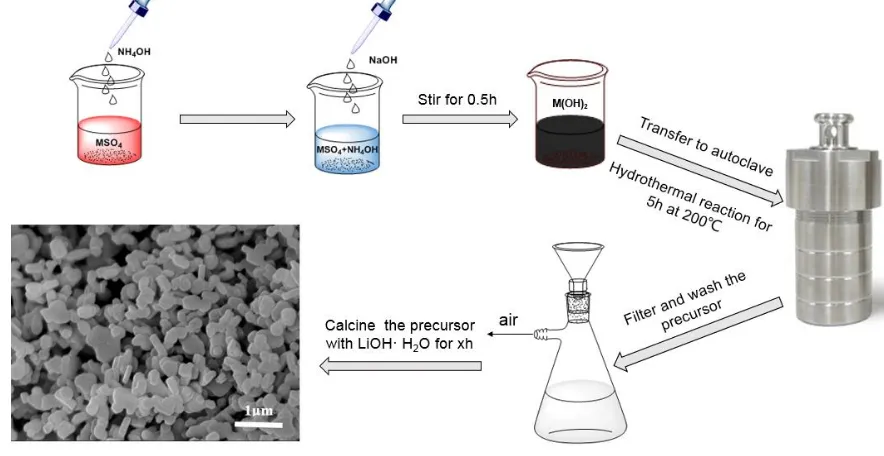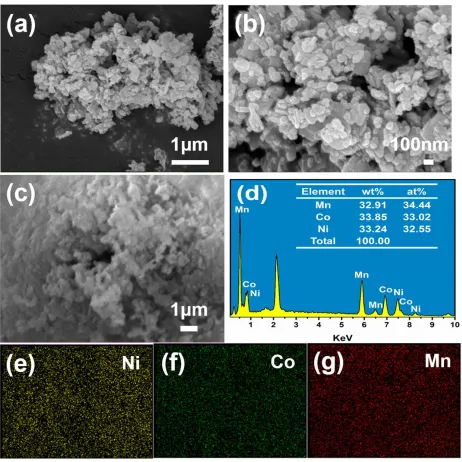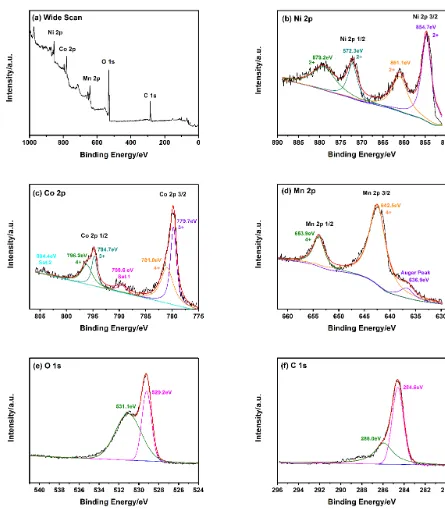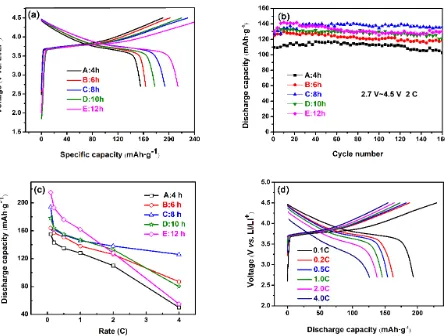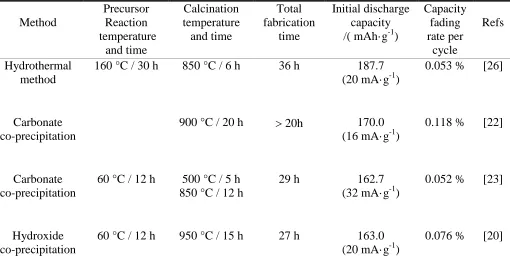Int. J. Electrochem. Sci., 13 (2018) 2248 – 2262, doi: 10.20964/2018.03.56
International Journal of
ELECTROCHEMICAL
SCIENCE
www.electrochemsci.org
Hydrothermally-assisted co-precipitation and Electrochemical
Performance of LiNi
1/3Co
1/3Mn
1/3O
2Cathode Material
Ruixue Zhang, Liwu Huang, Wei Li, Jinyu Liao, Pan Zeng, Xinlin Zhang, Yungui Chen*
College of Materials Science and Engineering, Sichuan University, Chengdu 610065, PR China *
E-mail: ygchen60@aliyun.com
Received: 3 November 2017 / Accepted: 26 December 2017 / Published: 5 February 2018
Hydrothermally-assisted co-precipitation method is conducted to prepare the precursor of layered materials LiNi1/3Co1/3Mn1/3O2. The LiNi1/3Co1/3Mn1/3O2 cathode materials are synthesized after calcining the as-prepared precursor for different hours at 850 °C. The temperature and high-pressure conditions that the hydrothermal-assisted method possesses can rapidly improve the crystallization speed of LiNi1/3Co1/3Mn1/3O2 precursor also with the well-defined layer structures and low degree of cation mixing. As the result, the hydrothermally-assisted co-precipitation method can save almost half the time of precursor reaction and calcination compared with reported co-precipitation methods. At the same time, the good comprehensive electrochemical performance can be obtained with the large initial discharge capacity of 193.5 mAh·g-1 at 0.1 C (1.0 C = 183.0 mA·g-1), the capacity fading rate per cycle of only 0.016 % based on 135 cycles and the high-rate discharge ability of 126 mAh·g-1 at 4.0 C. Adopting the hydrothermally-assisted co-precipitation method is very helpful to boost the utilization of production equipments and reduce the manufacturing cost of the LiNi1/3Co1/3Mn1/3O2 material.
Keywords: hydrothermally-assisted co-precipitation; LiNi1/3Co1/3Mn1/3O2; cathode; lithium-ion battery; production process
1. INTRODUCTION
conductivity as well as low temperature performance of LiFePO4 [13, 14] also prohibit their use in the future.
Many researchers make efforts to find a new kind of material which has relatively good safety performance and high specific energy. Layered material LiNi1/3Co1/3Mn1/3O2, owing to its high theoretical capacity (278.0 mAh·g-1), structural stability, safety and relatively low cost, is considered to be an ideal choice for hybrid electric vehicle (HEV) and to be the alternative of LiCoO2 cathode material [15-17]. The different transition metal elements Ni, Co and Mn, existing in + 2, + 3 and + 4 valence state respectively [18], are combined together to show the synergistic effects: Co reduces the degree of cation mixing between Li+ and Ni2+ in the lithium layer, Ni provides a high capacity and Mn maintains an outstanding stability of structure and reduces the cost.
In many reports, co-precipitation method is considered to be the best method for preparing spherical LiNi1/3Co1/3Mn1/3O2 materials because of the homogeneous and fine particles of precursor, especially in industry. Nonetheless, the co-precipitation method conditions must be strictly controlled and need a long time to prepare [19-21]. Park et al. [22] and Zhang et al. [23] used a carbonate co-precipitation technique to synthesize the Ni1/3Co1/3Mn1/3CO3 precursor and the latter was required to react at a constant temperature for 12 h. Santhanam et al. [24] prepared Ni1/3Co1/3Mn1/3(HO)2 precursor by a hydroxide co-precipitation at 50 °C for 20 h. More importantly, the crystallinity of precursor is unsatisfactory, resulting in longer calcination time. Park et al. [22] calcined the carbonate precursor for 20 h at 900 °C and Santhanam et al. [24] calcined the hydroxide precursor for 6 h at 400 °C and 12 h at 900 °C. It could be seen that the strict conditions and long-time reaction process were needed in these works.
Although the hydrothermal method is infrequent in the LiNi1/3Co1/3Mn1/3O2 synthesis, it is a promising process to obtain the stable electrochemical performance and improve the crystallinity of layered LiNi1/3Co1/3Mn1/3O2 [25]. High temperature and pressure of hydrothermal method in a sealed condition are helpful to improve the crystallinity of transition metal oxide cathode materials and then the lower calcination temperature and less calcination time can be adopted to save the cost and energy consumption. But the longer hydrothermal synthesizing time is still a nonnegligible problem. Wu et al. [26] synthesized LiNi1/3Co1/3Mn1/3O2 materials via hydrothermal method and the precursor reacted at 160 °C under auto-generated pressure for 30 h. After calcination for 6 h at 850 °C, the electrochemical performance was better than that of the traditional co-precipitation method.
In this work, we have succeeded in preparing layered LiNi1/3Co1/3Mn1/3O2 by the simple hydrothermally-assisted co-precipitation method with calcinations to aim at obviously reducing the total fabrication time. The synthesized samples showed integrated structures and good electrochemical performance which were investigated in detail.
2. EXPERIMENTAL
2.1 Materials preparation
[image:3.596.79.521.252.480.2]
the aqueous solution to make the NH4+ and M2+ (M = Ni, Co, Mn) mixed sufficiently. Then a 4.0 mol·L-1 NaOH solution was added with the ever-increasing stirring rate until pH = 11 was reached. The mixed suspension was stirred at room temperature for 0.5 h and then transferred to a 100 ml Teflon beaker autoclave. The autoclave was heated up to 200 °C and kept the temperature for 5 h and then cooled to room temperature naturally. The precursor powders were obtained through filtering, washing, and drying in a vacuum oven at 80 °C for 12 h to remove adsorbed water. The obtained precursor Ni1/3Co1/3Mn1/3(OH)2 and 5 % excess LiOH·H2O powders were mixed thoroughly and the mixture was first heated at 450 °C for 2 h and then calcined at 850 °C for 4, 6, 8, 10 and 12 h respectively in air to obtain LiNi1/3Co1/3Mn1/3O2 powders. The corresponding samples were referred as A, B, C, D and E. The synthesis process of LiNi1/3Co1/3Mn1/3O2 powders was shown in Fig. 1.
Figure 1. Schematic representation of synthesizing LiNi1/3Co1/3Mn1/3O2 powders.
2.2 Structure and morphology characterizations
X-ray diffraction (XRD) measurement was carried out using Cu target Kα (λ=1.5418 Å) radiation in the 2 θ range of 10 - 80 ° with a step size of 0.06 °·s-1
. The morphologies and surface microanalysis of the prepared powders were observed using scanning electron microscope (SEM) (JSM-6490LV and JSM-7500F) with the energy disperse spectroscopy (EDS) (51-XMX0019).
The valence states of the transition metals in LiNi1/3Co1/3Mn1/3O2 were measured in a vacuum condition and this operation was finished by X-ray photoelectron spectroscopy (XPS) (KRATOS MSAM-800).
2.3 Electrochemical performance measurements
positive electrode, prepared by blending 80 wt % LiNi1/3Co1/3Mn1/3O2 active materials, 10 wt % acetylene black and 10 wt % PVDF with the dispersing agent of NMP, was coated onto an aluminum foil current collector. The electrolyte was 1 mol·L-1 LiPF6 with EC + DMC (1:1 in volume). All cells were assembled in an Argon-filled glove box.
Cycling and rate tests were performed at a constant current with voltage between 2.7 to 4.5 V at 25 °C using CT2001A Land instrument. The cyclic voltammetry (CV) tests were operated on PARSTAT 2273 electrochemical workstation at 0.1 mv·s-1 between 2.7 V to 4.5 V. The electrochemical impedance spectroscopy (EIS) measurements were also performed by the same instrument, using an amplitude voltage of 5 mV and frequency range from 1 MHz to 5 mHz.
3. RESULTS AND DISCUSSION
3.1 Structure and morphology
Figure 2. XRD patterns of precursor powders: (a) before hydrothermal treatment; (b) after hydrothermal treatment.
[image:4.596.55.546.303.649.2]
and narrower diffraction peaks as well as higher intensity. It is reasonable to deduce that the hydrothermal treatment is beneficial to crystallize well. Moreover, both of the two precursors in the XRD patterns show broad integrated diffraction lines. This can be attributed to the mixture of transition metal carbonates such as Ni(OH)2, Co(OH)2 and Mn(OH)2 [26, 27].
Fig. 3(a) and (b) show the morphology of the hydrothermally treating precursor at different magnification. It is obvious that the primary particles are relatively fine and homogeneous with the size of about 100 nm. The EDS result of Fig. 3(d) corresponding to Fig. 3(c) indicates that the molar ratio of Ni:Co:Mn in precursor prepared by hydrothermally-assisted co-precipitation method is 1:0.96:0.95, which is very close to the initial ingredient (Ni:Co:Mn = 1:1:1). In addition, the mapping patterns in Fig. 3(e), (f) and (g) exhibit the homogeneous distribution of Ni, Co and Mn three elements.
[image:5.596.69.531.251.713.2]
Fig. 4 shows the X-ray powder diffraction patterns of the LiNi1/3Co1/3Mn1/3O2 powders calcined at 850 °C for different hours. Compared with the hydrothermally treating precursor, the crystallinity of the LiNi1/3Co1/3Mn1/3O2 materials has been enhanced. The obtained powders have the same α-NaFeO2 type layered structure with a R3
—
m space group and exhibit the single-phase LiNi1/3Co1/3Mn1/3O2 without any impurity phase [19, 28]. In the α-NaFeO2 type structure, the (006)/(102) and (108)/(110) in the XRD patterns characterizes the layered structure. In Fig. 4, the obvious peak splits in the (006)/(102) and (108)/(110) in all samples indicate the typical layered structures. The integrated intensity ratio (R) of (003)/(104) crystal planes indirectly indicates the mixing extent of cation Li+ (0.76 Å) and Ni2+ (0.69 Å) in the lithium layer [29]. Usually, the higher the ratio of I(003)/I(104), the lower the cation mixing degree of Li+ and Ni2+ and R = 1.2 is considered to be the boundary [19]. For the prepared materials A - E in Fig. 4, all of the I(003)/I(104) ratios are higher than 1.2, which prove that the LiNi1/3Co1/3Mn1/3O2 synthesized by hydrothermal assisting co-precipitation has a low degree of cation mixing. As a result, the best calcination time is 8 hours at 850 °C for the hydrothermally- assisted treating precursor.
Figure 4. XRD patterns of LiNi1/3Co1/3Mn1/3O2 powders with different calcination hours: (A) 4 h; (B) 6 h; (C) 8 h; (D) 10 h; (E) 12 h.
[image:7.596.53.544.151.398.2]
sample A with a short calcination time of 4 h, the smaller particles adhere to the bigger one, which is due to an incomplete reaction. The agglomeration appears in the sample E with a long calcination time of 12 h. Comparatively speaking, the sample C calcined for 8 h is deemed the optimal materials with clearly visible particle edges and average particle size of 300 nm.
Figure 5. SEM images of LiNi1/3Co1/3Mn1/3O2 powders with different calcination hours: (a) 4 h; (b) 6 h; (c) 8 h; (d) 10 h; (e) 12 h.
Figure 6. XPS spectra of (a) a wide scan, (b) Ni 2p, (c) Co 2p, (d) Mn 2p, (e) O 1s, (f) C 1s of LiNi1/3Co1/3Mn1/3O2 powders.
3.2 Electrochemical performance
[image:8.596.65.510.80.589.2][image:9.596.69.514.188.524.2]
229.5 mAh·g-1, 219.9 mAh·g-1 and 261.3 mAh·g-1 respectively. The corresponding discharge capacities are 163.5 mAh·g-1 (B), 193.5 mAh·g-1 (C), 177.7 mAh·g-1 (D) and 214.0 mAh·g-1 (E). The decomposition of electrolyte and the formation of a solid electrolyte interface (SEI) on the surface are the main reasons for irreversible capacity loss [18]. The discharge capacity of 8 h calcined sample C is a little lower than that of 12 h calcined sample E.
Figure 7. Electrochemical characterization of LiNi1/3Co1/3Mn1/3O2 electrode as the cathode of lithium-ion batteries: (a) initial charge-discharge curves at 0.1 C; (b) cycling performance at 2.0 C; (c) rate capability with different calcination hours: (A) 4 h, (B) 6 h, (C) 8 h, (D) 10 h, (E) 12 h. (d) Rate capability of sample C.
The discharge capacity vs cycle number of LiNi1/3Co1/3Mn1/3O2 is illustrated in Fig. 7(b). The tests were performed at a constant current density of 2.0 C and cycled between 2.7 to 4.5 V. After 135 times cycles, the capacity retentions of each sample are 88.95 % (A), 89.08 % (B), 97.79 % (C), 93.59 % (D) and 89.58 % (E) respectively, based on their largest discharge capacities. The results indicate that all of the samples possess good cycling performance. The sample C shows the highest discharge capacity and capacity retention.
are 155 mAh·g-1 (A), 164 mAh·g-1 (B), 194 mAh·g-1 (C), 178 mAh·g-1 (D) and 215 mAh·g-1 (E), respectively at 0.1 C and reduce to 50 mAh·g-1 (A), 87 mAh·g-1 (B), 126 mAh·g-1 (C), 80 mAh·g-1 (D) and 55 mAh·g-1 (E), respectively at 4.0 C. The 8 h calcined sample C has the best rate capacity with the highest discharge capacity of 126 mAh·g-1 at large current density of 4.0 C and the minimal influence of polarization, which is also clearly showed in Fig. 7(d). It is reasonable that the less cation mixing is beneficial for electrochemical performance.
The comparisons among the reported articles [20, 22-24, 26] and our work are enumerated in the Table 1. It is very obvious that the hydrothermally-assisted co-precipitation method requires much shorter precursor reaction and calcination time than single co-precipitation method. In Table 1, the total fabrication time is 15 h for the LiNi1/3Co1/3Mn1/3O2 prepared by hydrothermally-assisted method while at least about 27 h or longer for that prepared by co-precipitation method. The calcination temperature is 900 °C in the article [22] and [24] as well as 950 °C in the articles [20] but the calcination temperature is only 850 °C for the hydrothermally-assisted precursor in this work. Besides, the hydrothermally-assisted LiNi1/3Co1/3Mn1/3O2 has the largest initial discharge capacity of 193.5 mAh·g-1, its capacity fading rate per cycle is only 0.016 % while their capacity fading rates per cycle are from 0.052 % to 0.118 % for all of the LiNi1/3Co1/3Mn1/3O2 materials through co-precipitation method. In summary, the hydrothermally-assisted co-precipitation method can shorten obviously the fabrication time of the LiNi1/3Co1/3Mn1/3O2 material, which is helpful to boost the utilization of production equipments and reduce the manufacturing cost of the LiNi1/3Co1/3Mn1/3O2 material.
Table 1. Summary of the electrochemical performance of previous lithium-ion batteries based on LiNi1/3Co1/3Mn1/3O2 cathodes compared to this work
Method Precursor Reaction temperature and time Calcination temperature and time Total fabrication time Initial discharge capacity /( mAh·g-1)
Capacity fading rate per cycle Refs Hydrothermal method
160 °C / 30 h 850 °C / 6 h 36 h 187.7 (20 mA·g-1)
0.053 % [26]
Carbonate co-precipitation
900 °C / 20 h 20h 170.0 (16 mA·g-1)
0.118 % [22]
Carbonate co-precipitation
60 °C / 12 h 500 °C / 5 h 850 °C / 12 h
29 h 162.7
(32 mA·g-1)
0.052 % [23]
Hydroxide co-precipitation
60 °C / 12 h 950 °C / 15 h 27 h 163.0 (20 mA·g-1)
[image:10.596.46.556.452.715.2]
Hydroxide co-precipitation
50 °C / 24 h 400 °C / 6 h 900 °C / 12 h
42 h 148.0
(160 mA·g-1)
0.100% [24]
Hydrothermally-assisted co-precipitation
method
25 °C / 0.5 h 200 °C / 5.0 h
450 °C / 2 h 850 °C / 8 h
15.5 h 193.5
(18.3 mA·g-1 )
0.016 % This work
[image:11.596.68.530.279.599.2]3.3 Cyclic voltammetry (CV)
Figure 8. Cyclic voltammetry of sample C between 2.7 and 4.5 V at a scan rate of 0.1 mV·s-1.
LiNi1/3Co1/3Mn1/3O2 ch ar g e di sch ar g e
Li1-x(Ni2+ 1/3-xNi
3+
x )Co1/3Mn1/3O2 + x Li
+
+ x e- (0 ≤ x ≤ 1/3, 3.8 - 4.1V) (1)
Li2/3Ni
3+
1/3Co1/3Mn1/3O2
ch ar g e di sch ar g e
Li1-x(Ni
3+ 2/3-xNi
4+
x-1/3)Co1/3Mn1/3O2 + (x-1/3) Li+ + (x-1/3) e- (1/3
≤ x ≤ 2/3, 3.8 - 4.1 V) (2) After the first cycle, the curves of the second and third cycle are almost overlapped. The
voltage values of anodic peaks and cathodic peaks corresponding to the curve 2 and 3 are shown in Fig.8, and the V are 0 V for anodic peaks and 0.014 V for cathodic peaks respectively, indicating that the electrode has a stable structure and a good reversibility. However, the intensity of the two anodic peaks slightly decrease than that of the first curve, owing to the irreversible capacities after the first cycle.
3.4 Electrochemical impedance spectroscopy (EIS)
Electrochemical impedance spectroscopy (EIS) was applied to study the Li+ ions diffusion. Fig. 9(a) is the EIS comparisons of LiNi1/3Mn1/3Co1/3O2 cells with different calcination hours and the impedance results are fitted by the same equivalent circuit. At the Z′ axis, a high-frequency intercept is mainly the electrolyte (Re). The curves contain a high-frequency semi-circle and a slash at the low frequency [38, 39]. The former represents the solid electrolyte interface resistance (RSEI) and the charge transfer resistance (Rct) between the electrolyte and electrode, while the latter exhibits diffusion of Li+ in the electrode, i.e. Warburg impedance (W), respectively. As shown in Fig. 9(a), the overall impedance decreases first and then increases with calcination time extension and the 8 h is the turning point, illustrated by the size changes of the semi-circles. The statistical datas of Re and RSEI + Rct in Table 2 further confirm the result. The lithium-ion diffusion coefficient D (cm2·s-1) can be calculated from the formula on the basis of EIS diagram as following: [40, 41]
D=R2T2/2A2n4F4C2σ2 (3)
[image:13.596.51.546.688.765.2]
Figure 9. (a) The comparison of EIS of LiNi1/3Mn1/3Co1/3O2 cells with different calcination hours: (A) 4 h, (B) 6 h, (C) 8 h, (D) 10 h, (E) 12 h. Slope fitted curves of (b) 4h; (c) 6h; (d) 8h; (e) 10h; (f) 12h.
Table 2. The resistance and lithium-ion diffusion coefficient in cathode at different calcination hours
Sample Re / Ω RSEI + Rct / Ω DLi+/ (cm2·S-1)
A: 4 h 8.4295 132.9114 1.646 10-15
B: 6 h 2.7010 110.9012 2.381 10-15
C: 8 h 3.8227 104.5124 5.382 10-15
D: 10 h 12.5693 811. 2186 2.896 10-17
4. CONCLUSIONS
Hydrothermally-assisted co-precipitation method is employed to prepare the precursor of layered materials LiNi1/3Co1/3Mn1/3O2. The high-temperature and high-pressure conditions that the hydrothermal-assisted method possesses can rapidly improve the crystallization speed of LiNi1/3Co1/3Mn1/3O2 precursor. As the result, the hydrothermally-assisted co-precipitation method requires much shorter precursor reaction and calcination time and at the same time the good comprehensive electrochemical performance can be obtained. The total fabrication time is 15 hours for the LiNi1/3Co1/3Mn1/3O2 prepared by hydrothermally-assisted method and at least about 27 hours or longer for that prepared by reported co-precipitation methods. Besides the hydrothermally-assisted LiNi1/3Co1/3Mn1/3O2 has the large initial discharge capacity of 193.5 mAh·g-1 and good high-rate capacity of 126 mAh·g-1 at 4.0 C, its capacity fading rate per cycle is only 0.016 % which is much lower than that reported through precipitation methods. Adopting the hydrothermally-assisted co-precipitation method is very helpful to boost the utilization of production equipments and reduce the manufacturing cost of the LiNi1/3Co1/3Mn1/3O2 material.
ACKNOWLEDGEMENTS
This work was financially supported by the Research Project of Baosheng Industrial Development Co., Ltd. [Grant No. 15H1107].
References
1. K. Mizushima, P. C. Jones, P. J. Wiseman and J. B. Goodenough, Mater. Res. Bull., 15 (1980) 783. 2. J. B. Goodenough and K. Mizuchima, US 4302518, (1981).
3. R. Koksbang, J. Barker, H. Shi and M. Y. Saïdi, Solid State Ion., 84 (1996) 1.
4. J. M. Tarascon, E. Wang, F. K. Shokoohi, W. R. McKinnon and S. Colson, J. Electrochem. Soc., 138 (1991) 2859.
5. Y. Xia and M. Yoshio, J. Electrochem. Soc., 143 (1996) 825.
6. A. K. Padhi, J. B. Goodenough and K. S. Nanjundaswamy, J. Electrochem. Soc., 144 (1997 ) 1188. 7. A. Yamada, S. C. Chung and K. Hinokuma, J. Electrochem. Soc., 148 (2001) A224.
8. L. Xiao, Y. Yang, Y. Zhao, X. Ai, H. Yang and Y. Cao, J. Solid State Electrochem., 12 (2008) 149. 9. T. E. Hong, E. D. Jeong, S. R. Baek, M. R. Byeon, Y. S. Lee, F. N. Khan and H. S. Yang, J. Appl.
Electrochem., 42 (2012) 41.
10.R. Thirunakaran, T. Kim and W. S. Yoon, J. Appl. Electrochem., 44 (2014) 709. 11.Y. Shin and A. Manthiram, J. Electrochem. Soc., 151 (2004) A204.
12.G. D. Bent, G. F. Adams, R. H. Bartram, G. D. Purvis and R. J. Bartlett, J. Chem. Phys., 13 (1982) 4144.
13.X. Fang, J. Li, K. Huang, S. Liu, C. Huang, S. Zhuang and J. Zhang, J. Solid State Electrochem., 16 (2012) 767.
14.W. Su, K. Xu, G. Zhong, Z. Wei, C. Wang and Y. Meng, Int. J. Electrochem. Sci., 12 (2017) 6930. 15.K. M. Shaju and P. G. Bruce, Adv. Mater., 18 (2006) 2330.
16.J. B. Goodenough and Y. Kim, Chem. Mater., 22 (2010) 587.
17.W. Hua, Y. Wang, Y. Zhong, G. Wang, B. Zhong, B. Fang and X. Guo, Chin. J. Chem., 33 (2015) 261.
19.M. H. Lee, Y. J. Kang, S. T. Myung and Y. K. Sun, Electrochim. Acta, 50 (2004) 939. 20.H. J. Noh, S. Youn, S. Y. Chong and Y. K. Sun, J. Power Sources, 233 (2013) 121.
21.F. Fu, G. L. Xu, Q. Wang, Y. P. Deng, X. Li, J. T. Li, L. Huang and S. G. Sun, J. Mater. Chem. A., 1 (2013) 3860.
22.S. H. Park, S. H. Kang, I. Belharouak, Y. K. Sun and K. Amine, J. Power Sources, 177 (2008) 177. 23.S. Zhang, C. Deng, B. L. Fu, S. Y. Yang and L. Ma, Powder Technol., 198 (2010) 373.
24.R. Santhanam and B. Rambabu, J. Power Sources, 195 (2010) 4313.
25.J. Fan, G. Li, D. Luo, C. Fu, Q. Li, J. Zheng and L. Li, Electrochim. Acta., 173 (2015) 7. 26.F. Wu, M. Wang, Y. Su, L. Bao and S. Chen, J. Power Sources, 195 (2010) 2362.
27.T. H. Cho, S. M. Park, M. Yoshio, T. Hirai and Y. Hideshima, J. Power Sources, 142 (2005) 306. 28.K. W. Nam, S. M. Bak, E. Hu, X. Yu, Y. Zhou, X. Wang, L. Wu, Y. Zhu, K. Y. Chung and X. Q.
Yang, Adv. Funct. Mater., 23 (2013) 1046.
29.S. C. Yin, Y. H. Rho, I. Swainson and L. F. Nazar, Chem. Mater., 18 (2006) 1901.
30.J. Liang, R. Ma, N. Iyi, Y. Ebina, K. Takada and T. Sasaki, Chem. Mater., 22 (2010) 371. 31.C. Zhen, W. Jin, D. Chao, B. Tom, L. Bai, C. Shi, Y. Zhao, S. T. Chien, J. Lin and Z. Shen, Sci.
Rep., 6 (2016) 25771.
32.M. Li, J. P. Cheng, F. Liu and X. B. Zhang, Chem. Phys. Lett., 640 (2015) 5.
33.L. Gu, L. Qian, Y. Lei, Y. Wang, J. Li, H. Yuan and D. Xiao, J. Power Sources, 261 (2014) 317. 34.J. W. Lee, T. Ahn, D. Soundararajan, J. M. Ko and J. D. Kim, Chem. Commun., 47 (2011) 6305. 35.M. O'Connell, A. K. Norman, C. F. Hüttermann and M. A. Morris, Catal. Today, 47 (1999) 123. 36.B. Liu, Y. Zhang and L. Tang, Int. J. Hydrogen Energy, 34 (2009) 435.
37.Y. Koyama, I. Tanaka, H. Adachi, Y. Makimura and T. Ohzuku, J. Power Sources, 119 (2003) 644. 38.K. M. Shaju, G. V. S. Rao, B. V. R. Chowdari, J. Electrochem. Soc., 151 (2004) A1324.
39.J. Li, R. Yao and C. Cao, ACS Appl. Mat. Interfaces, 6 (2014) 5075.
40.L. Wang, J. Zhao, X. He, J. Gao, J. Li, C. Wan and C. Jiang, Int. J. Electrochem. Sci., 7 (2012) 345.
41.X. Wang, H. Hao, J. Liu, T. Huang and A. Yu, Electrochim. Acta, 56 (2011) 4065
